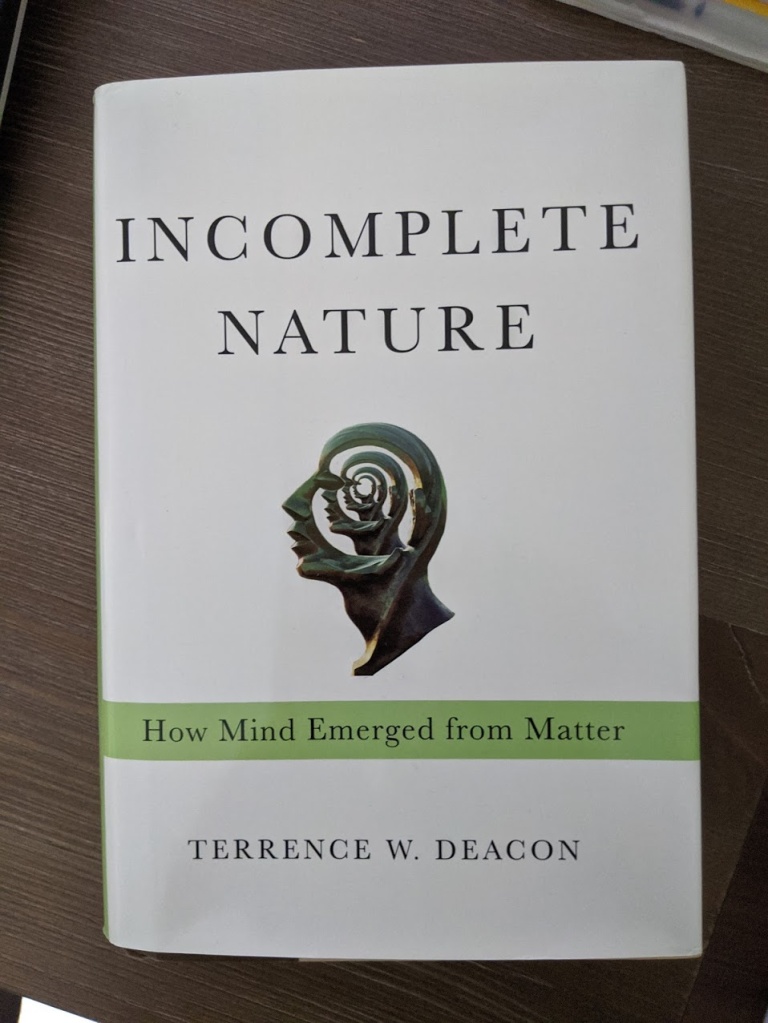
Terrence W. Deacon’s 2012 book Incomplete Nature is a bold attempt to conceptualize the emergence of life and mind using a consistent ‘physicalist’ framework. I put the term ‘physicalist’ in scare-quotes because one of the appealing quirks of the book — and perhaps one that isn’t given enough attention despite a length of 500+ pages — is that Deacon wants us to add something to the list of physical things, which typically only includes matter and energy. This something is… nothing. The incompleteness in the title seems to refer to this idea: a qualified nothing or absence is central to emergence.
The book is by turns intriguing and exasperating. Deacon’s emphasis on the usefulness of absence and constraint in physicalist discourse is admirable. And his treatments of familiar concepts like resonance, entropy and work should prove stimulating even for people who know the physics inside out. The main source of irritation for me is the prose: the stacking of invented terms on top of each other leads to a wobbly Jenga tower of clunky clauses. Deacon loves his neologisms and his redefinitions of existing terms. I suppose anyone interested in pushing science and philosophy forward will need to invent some jargon. But here the jargon risks alienating many otherwise sympathetic readers. Another barrier is the sheer length of the book, which arises as much from repetition as from a desire to cover the topics thoroughly. One gets the impression that there is a much shorter and more metaphysically radical book lurking within this one, screaming to get out.
My plan is to do a series of posts on Deacon’s key terms, so people who can’t get past the prolixity and the weird writing can access the concepts, which may prove handy for thinking about emergence in biology and beyond.
As a preview, here are brief intros to each of his major neologisms.
The Deactionary
ententional: This is Deacon’s adjective for referential or directed processes such as functions, goals, and representations. It derives from the term ‘intentionality’, which is the philosopher’s term of art for the directedness of mind towards its objects of thought and perception — its “aboutness”. Deacon feels that we need a separate term that captures aboutness but does not connote anything mental.
homeodynamic: A system is homeodynamic if its spontaneous, natural or unforced path leads towards equilibrium. Homeodynamics erases differences (e.g., in temperature or pressure).
morphodynamic: A system is morphodynamic if it tends to spontaneously increase in order. This generally involves external perturbations, but does not involve external design or imposition of form. Morphodynamics subsumes many standard examples of self-organization. Morphodynamics amplifies differences.
teleodynamic: A system is teleodynamic if its organization becomes spontaneously end-directed. Teleodynamic systems employ homeodynamic and morphodynamic processes in the service of a self. Terms like ‘self-maintenance’ and ‘self-repair’ become natural and unavoidable in teleodynamic systems.
orthograde: The orthograde trajectory of any system is the spontaneous trajectory it takes when there is no additional interference. It means following the grade or gradient: going with the flow.
contragrade: A contragrade change must be forced on a system, and is therefore non-spontaneous. Contragrade changes involve one orthograde process acting upon another.
Some of his more dense sentences involve these terms sandwiched with his versions of the following: absence, constraint, supervenience, work and information. Here’s are some examples:
“Morphodynamic processes are the only spontaneous processes that generate and propagate constraints, and autogens demonstrate that reciprocity between morphodynamic processes can preserve and replicate constraints.”
“Teleodynamic systems can interact homeodynamically; homeodynamic relationships between teleodynamic systems can produce morphodynamic relationships; and synergistically reciprocal morphodynamic relationships constituted by interacting teleodynamic systems can produce higher-order teleodynamic relationships.”
“Teleodynamic orthograde processes are more complex because they dynamically supervene on morphodynamic processes.”
“Information is dependent on the propagation of constraints linking a teleodynamic system and its environmental context.”
Whew!
Anyway, I am pretty sure statements of this sort can be decompressed without too much pain, and often contain real insights. Also, perhaps in keeping with the importance of absence, the ideas that Deacon neglects may be as interesting as the ones he draws attention to.

5 replies on “The Deactionary: A glossary of terms from Terrence Deacon’s ‘Incomplete Nature’”
Slight typo, I think?
“This generally involves external perturbations, but does not involve no external design or imposition of form.” A double-negative?!?
Whoops! Ain’t no way I can leave that there. Thanks!
[…] Terrence Deacon’s book Incomplete Nature: How Mind Emerged From Matter. I’m calling it the Deactionary, since Deacon is fond of coining new terms and redefining old […]
Brilliant, it is such an incredible book but so hard to understand partly because of the use of new terms (though maybe that’s necessary to have captured the concepts!). I like to flick to the middle of the book every now and then and read a sentence out loud, chances are any randomly selected sentence contains a couple of terms defined earlier in the book, one of which had to be defined in chapter 3/4 based on terms he’d introduced in chapters 1/2… ” Your description of “the stacking of invented terms on top of each other leads to a wobbly Jenga tower of clunky clauses” is spot on!
Thanks! And yes… there is so much excellent food for thought there, but the neologisms are not super helpful.